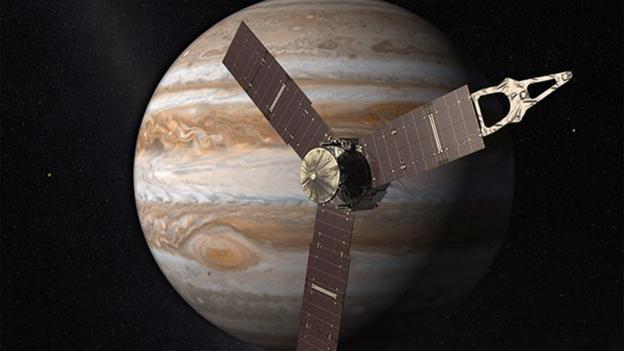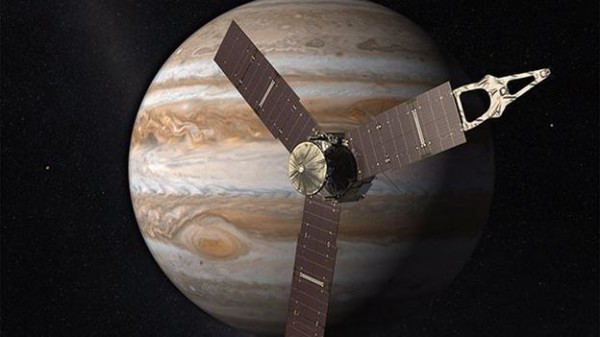
Why a probe passing our planet on its way to Jupiter might end a decades-old mystery, and reveal something completely new about gravity.
You may not see it, but sometime today, a spacecraft whizzing 350 miles (560km) above Earth is going to use our planet to slingshot its way towards another one. In the process, a group of scientists are hoping the craft will help reveal a mystery that has perplexed them for decades.
When Nasa’s Juno spacecraft arrives at Jupiter three years from now, it will investigate the planet’s origin and evolution by mapping magnetic and gravitational fields. But before it does that, the probe has an opportunity to contribute to a momentous discovery right here in our celestial backyard, and potentially pave the way for the discovery of entirely new physics.
Spacecraft like Juno routinely use flybys of Earth to gain speed and slingshot themselves towards the outer solar system. Occasionally, however, passing spacecraft seem to get an extra boost, picking up more speed than calculations suggest they should. The energy kick is known as the flyby anomaly, and this has happened too many times now to be shrugged off as trivial. Instead, something unidentified is affecting the velocity of spacecraft at their closest approach to our planet. When Juno swings by Earth, all eyes will be on the spacecraft to see if it can help figure out what is going on.
The most likely explanation is that it is a miscalculation in the tracking software, but there is a tantalising possibility that navigators are seeing unanticipated physics beyond our present theories of gravity. If so, it would open up a whole new landscape of understanding about the fundamental nature of the universe.
“If we were to establish that the Earth flyby anomaly really resulted from new physics, that would be of major significance,” says Chuck Scott, Juno mission manager at Nasa’s Jet Propulsion Laboratory (JPL) in Pasadena, California.
It’s anyone’s guess what any new discovery of this type could yield, but previous breakthroughs in gravitational physics have revolutionised our way of thinking. In the 17th Century the work of Isaac Newton helped trigger the Age of Enlightenment. In the 20th Century, Albert Einstein’s General Relativity led to our discovery of black holes and the big bang. It also made more down-to-Earth applications possible, such as satellite navigation.
However, Scott is cautious about such heady speculation. “Extraordinary claims require extraordinary evidence,” he says. “Most scientists expect that it will turn out to be a software, or some other minor, miscalculation, rather than new physics.” But only by finding the cause of the surge will we know. Which is why researchers will be examining Juno in as much detail as possible to see what’s going on.
Speed mystery
The flyby anomaly was first noticed in 1990, during a close pass by another Jupiter-bound spaceprobe. When Nasa’s Galileo craft shot less than 620 miles (1,000km) above the surface of the Earth, navigators noticed a small discrepancy in the radio signal as it headed off. It could be understood only if the spacecraft had picked up about 4 millimetres per second more speed than they were expecting.
It may sound minuscule, especially as the spacecraft was travelling at 8.5 miles per second (13.74kps). But the extra speed was clearly noticeable and defies explanation. The team examined the navigation software used by Nasa and the basic mathematical models that the flight teams relied on to calculate where their spacecraft were heading. Yet everything seemed fine. There was nothing that could account for the extra speed.
So the team hunkered down, waited and prepared. Galileo would be back in 1992 for a second pass of Earth, and it would be even closer this time. They made special arrangements with Nasa’s Tracking and Data Relay Satellite System to pay particular attention around the time of closest approach. But it was all in vain. At its flyby altitude of just 185 miles (300km), the probe encountered the last wisps of Earth’s atmosphere, which was enough to slow it down and mask any unexpected increase in velocity.
With Galileo now heading off for Jupiter, it seemed as if the conundrum would remain unsolved. Then, on 28 January 1998, Nasa’s Near Earth Asteroid Rendezvous mission lined up for its slingshot, and emerged more than 13mm per second faster than navigators were expecting. The mystery was back.
The problem with the mystery is that it isn’t clear cut. In 2005, the European Space Agency’s comet chaser Rosetta experienced a small but noticeable flyby anomaly as it swept round the Earth for the first of three flybys. “When we saw the anomaly, we were shocked,” says Trevor Morley, Flight Dynamics Analyst at ESA’s European Space Operations Centre in Darmstadt, Germany. After a lengthy investigation, the ESA tracking team concluded that the 1.8mm per second gain was real.
Two years later, they set about preparing for when Rosetta would be back for its second pass. Based on previous anomalies, they expected to see a velocity increase of about 1 mm/sec. But they saw nothing; not even a hint. They tried again in 2009, during Rosetta’s third and final pass. Again, they detected nothing.
“We were really hoping to see something on that third pass. We prepared very well and were really disappointed not to see anything,’ says Morley, marking perhaps the first time in history an engineer was disappointed because his spacecraft performed exactly as expected.
Morley thinks that the anomaly may not have shown up because the flybys were high, more than 1,200 miles (2,000km) above Earth’s surface. Similarly, Nasa’s Mercury mission Messenger sailed past Earth in 2005 at 2,336 kilometres with no unexpected gain in speed.
This is why Juno’s flyby is so important. For the first time in fifteen years, a spacecraft will slingshot around the Earth at low altitude, at about 310 miles (500km). This could produce an effect as large as 6mm per second.
Close encounter
Preparations for this flyby began months ago. “We are scheduling tracking support from a pair of ESA tracking stations that we would have not otherwise scheduled,” says Scott. ESA stations in Argentina and Australia will see Juno up to a few minutes before closest approach and then again about 10-15 minutes afterwards. Yet, in a piece of bad luck, there is no tracking station available to watch Juno during the closest part of its encounter, which takes place above South Africa. It is at its closest approach that the anomaly is assumed to take place.
Nevertheless, Nasa scientists are eagerly awaiting the tracking data that will be available, especially by those who helped solve another spacecraft navigational puzzle. The behaviour of Nasa’s Pioneer 10 and 11 spacecraft vexed minds for decades, as it looked as if the Sun was exerting a slightly greater pull of gravity than expected from Newton’s theory. After a great deal of international effort and years of work to analyse the tracking data, the explanation was revealed to be a more mundane effect – it was the excess heat bouncing off the back of the spacecraft’s main antenna.
Could something similar be responsible for the flyby anomaly? Orfeu Bertolami Neto, a physicist from University of Porto, Portugal, thinks not. “The flyby anomaly acceleration is much larger than the Pioneer anomaly,” he says. And a 2011 analysis of ESA’s Rosetta mission by Benny Rievers and Claus Lammerzahl, both from the Center of Applied Space Technology and Microgravity (ZARM), University of Bremen, Germany, came to the conclusion that its flyby anomaly could not be explained in the same way as Pioneer. With that explanation discounted, the only route forward is to collect more data, and that means more flybys.
To make the Juno data even more valuable, Nasa will power up its accelerometers for the flyby to complement the tracking data. “[Juno’s] accelerometers are sensitive enough to detect the size of the typical anomaly provided it occurs over a short enough time – less than about 10 minutes,” says William Folkner, head of the gravity science team at JPL.
Assuming the anomaly does occur, a sensitive instrument called an accelerometer might give theoreticians their first real insight into the physics behind the velocity jump. A zero accelerometer reading would show it to be the result of a gravitational effect. Any other reading would indicate an external force has acted on the spacecraft.
Galaxy quest
Looking beyond the Juno flyby, Bertolami had proposed a small mission dedicated to studying the anomaly. He envisaged a small independent microsatellite that would constantly orbit the Earth on trajectories that mimic flybys. It would stay in constant touch with ESA’s Galileo satellite navigation system, calculating its position so that any unexpected acceleration could be caught as it happened.
Although that particular proposal seems to have run aground, another proposed ESA spacecraft could do the same job. The Space-Time Explorer and Quantum Equivalence Principle Space Test (STE-Quest) is an ESA candidate mission for launch by 2024. If selected, the mission will explore the force of gravity, but Jorge Paramos, a physicist at Technical University of Lisbon, Portugal, and Gerald Hechenblaikner, Astrium Satellites, Germany, have suggested the spacecraft could also be used to investigate the flyby anomaly, with virtually no change to its original mission and no extra instruments.
As part of its primary mission, STE-Quest will monitor the movement of atoms under the free-fall conditions of space. To do this successfully, it will use the Galileo satellites and an accelerometer to know exactly where it is, and how it is moving. It turns out that this information could also pinpoint the flyby anomaly as STE-Quest swings by Earth repeatedly on its elliptical orbit.
If STE-Quest were funded – and any positive signal from Juno this month could make the mission look even more desirable – it would then provide a flood of data for the task of deciding whether there is a simple (relatively speaking) explanation for the flyby anomaly, an unanticipated facet of relativity, for example, or an effect based upon the Earth not being completely round, or truly new physics at work.
Whatever it turns out to be, after decades of head scratching and frustration, there is now a real chance of making progress. All we need is for the anomaly to turn up again on cue. Any time now, hopefully.



Leave a reply